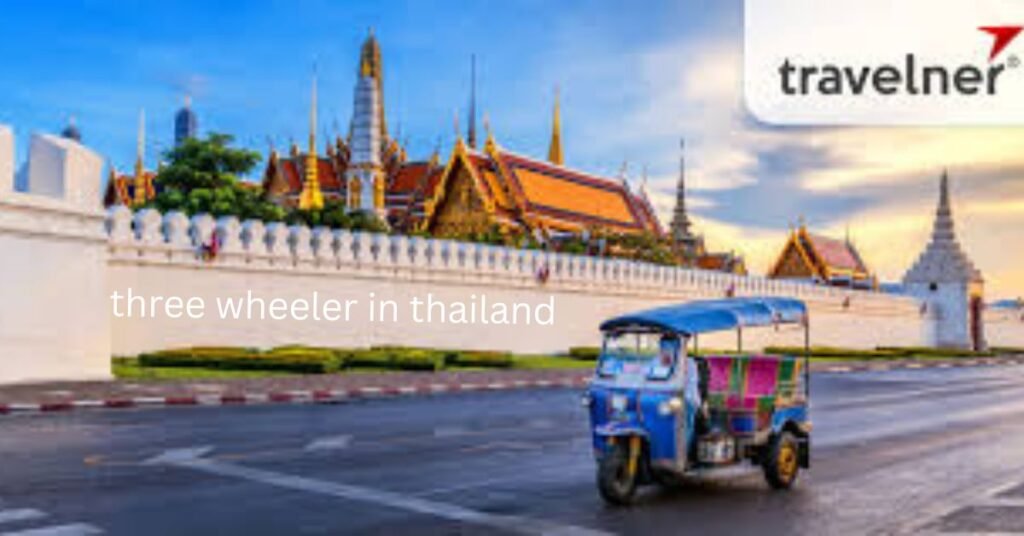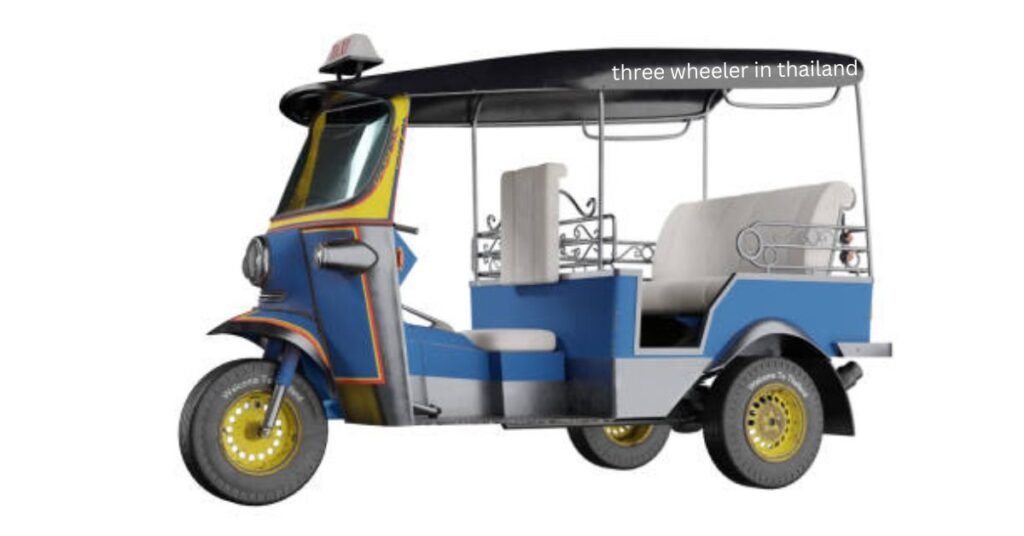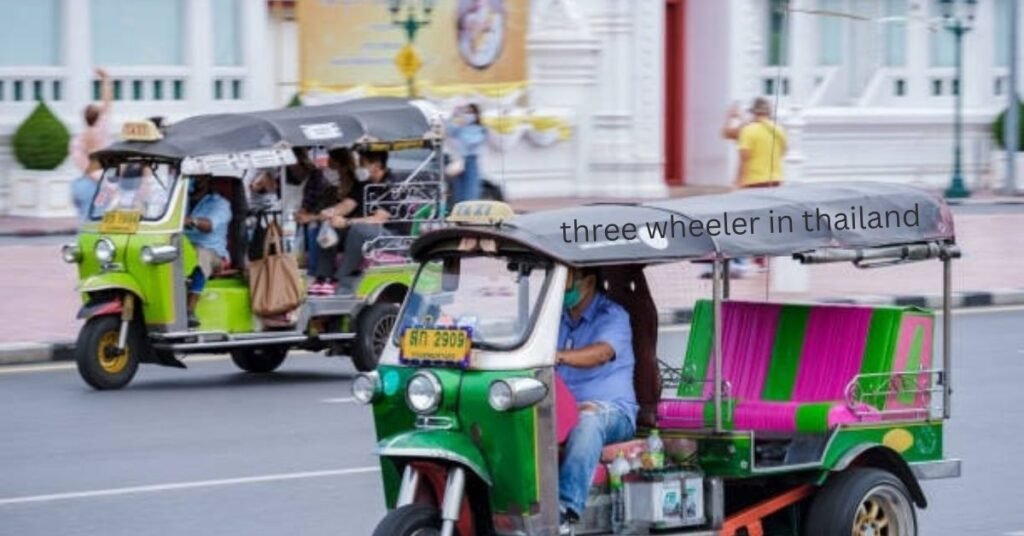Thailand, a country known for its vibrant culture, stunning landscapes, and bustling cities, offers an array of unique transportation options. Among these, the Three Wheeler in Thailand, stands out as a quintessentially Thai mode of travel. In this comprehensive guide, we will delve into the history, cultural significance, practicalities, and experiences associated with three-wheelers in Thailand. By the end of this article, you’ll have a thorough understanding of why the three-wheeler is more than just a vehicle—it’s a cultural icon and a vital part of Thailand’s transportation landscape.
The History of Three Wheelers in Thailand
Three Wheeler in Thailand can be traced back to the early 1960s. The introduction of the tuk-tuk came as a response to the need for an affordable and efficient mode of transport for the burgeoning urban population. Originally based on the design of the Japanese Auto Rickshaw, the tuk-tuk was adapted to meet the specific needs of Thai streets and conditions.
The name “Three Wheeler in Thailand derived from the sound the vehicle’s engine makes—a distinctive “tuk-tuk” noise that has become synonymous with the experience of riding one. Over time, the tuk-tuk has evolved from a basic mode of transportation into a symbol of Thai culture and tourism, thanks to its unique design and the vibrant colors often used in its decoration.
Design and Functionality of Three-Wheelers

The Desig
The traditional Thai tuk-tuk is a small, Three Wheeler in Thailand vehicle designed to navigate the narrow streets and alleys of Thai cities and towns. It typically features an open-air design with a metal frame and a canvas or fiberglass roof. The seating area, which usually accommodates two to three passengers, is situated at the back of the vehicle, while the driver sits at the front.
The tuk-tuk’s compact size allows it to maneuver through heavy traffic more easily than larger vehicles, making it an ideal choice for navigating the congested streets of cities like Bangkok. The vehicle is powered by a small engine, often a two-stroke or four-stroke engine, which provides enough power to carry passengers and their luggage while maintaining fuel efficiency.
Functionality
One of the key advantages of the Three Wheeler in Thailand is its versatility. Tuk-tuks are used for a variety of purposes beyond just passenger transport. In many areas, they are employed as delivery vehicles, transporting goods and produce to local markets. Their ability to navigate tight spaces and their relatively low operating costs make them a practical choice for small businesses and vendors.
In addition to their practical uses, tuk-tuks have become a popular tourist attraction. Many visitors to Thailand choose to ride tuk-tuks as a way to experience the local culture and enjoy a unique and memorable form of transportation. The vibrant colors, distinctive design, and open-air seating of the tuk-tuk offer a sensory-rich experience that is distinct from more conventional modes of travel.
The Cultural Significance of Three-Wheelers

A Symbol of Thai Identity
The three-wheeler has become a symbol of Thai identity and culture. Its presence in bustling urban centers, serene rural areas, and tourist hotspots alike highlights its role in the daily lives of Thais. For many locals, the tuk-tuk represents a sense of community and connectivity, as these vehicles are often used to transport friends and family, run errands, and engage in social activities.
The vibrant colors and elaborate decorations often seen on tuk-tuks are a reflection of Thailand’s artistic traditions and cultural heritage. Many tuk-tuks are adorned with intricate designs, bright patterns, and decorative elements that showcase the creativity and craftsmanship of their owners. This personalized touch adds to the charm and appeal of the tuk-tuk, making it an integral part of the visual landscape of Thai cities and towns.
The Role in Tourism
For tourists, the tuk-tuk represents an opportunity to engage with Thai culture in a fun and immersive way. Riding a tuk-tuk offers a unique perspective on the city, allowing visitors to experience the sights, sounds, and smells of Thailand up close. The open-air design provides an unobstructed view of the surroundings, while the driver’s local knowledge and storytelling can enhance the overall experience.
Tuk-tuks are also a popular choice for sightseeing tours. Many operators offer guided tours of major attractions, markets, and neighborhoods, providing tourists with a convenient and enjoyable way to explore different parts of the city. The informal and personal nature of a tuk-tuk ride often allows for more spontaneous and memorable interactions with locals and fellow travelers.
Practical Tips for Riding a Three-Wheeler

Finding a Tuk-Tuk
In major cities like Bangkok and Chiang Mai, tuk-tuks are readily available and can be found at key tourist spots, markets, and transport hubs. In more rural areas, they may be less frequent but can often be hailed from the side of the road or arranged through local contacts. Many hotels and guesthouses also offer tuk-tuk services or can help arrange rides for their guests.
Negotiating Fares
One of the unique aspects of riding a tuk-tuk is the negotiation process. Unlike metered taxis, tuk-tuks typically operate on a fixed fare basis, and prices can vary depending on the distance, time of day, and location. It is common practice to negotiate the fare with the driver before starting the journey. To ensure a fair price, it is helpful to have a general idea of the route and distance, and to compare prices with other tuk-tuk drivers if possible.
Safety and Comfort
While tuk-tuks are generally safe, it’s important to exercise caution when riding. Be aware of your surroundings, keep an eye on your belongings, and ensure that the vehicle is in good condition before starting your journey. Wearing a seatbelt is not typically required, but it is a good idea to hold on firmly during the ride, as the open-air design can make the experience a bit bumpy.
Tuk-tuks are not air-conditioned, so it’s advisable to dress comfortably and stay hydrated, especially during hot weather. If you’re traveling during the rainy season, be prepared for the possibility of rain and consider bringing an umbrella or raincoat.
Respecting Local Customs
When riding a tuk-tuk, it’s important to be respectful of local customs and practices. Greet the driver politely, and be mindful of local traffic rules and regulations. Engaging in friendly conversation and showing appreciation for the driver’s services can enhance the overall experience and contribute to a positive interaction.
The Future of Three Wheelers in Thailand
As Thailand continues to modernize and develop its transportation infrastructure, the role of the tuk-tuk is evolving. In recent years, there has been a growing focus on sustainability and reducing emissions, leading to the introduction of electric tuk-tuks. These environmentally friendly alternatives offer a quieter and cleaner mode of transport while preserving the traditional charm of the three-wheeler.
The rise of electric tuk-tuks aligns with broader efforts to address environmental concerns and promote sustainable tourism. Many cities and municipalities are investing in infrastructure and policies that support the use of electric vehicles, including tuk-tuks. This shift represents a positive step towards reducing the carbon footprint of transportation while maintaining the cultural and historical significance of the tuk-tuk.
Conclusion
Three Wheeler in Thailand, or tuk-tuk, is more than just a mode of transportation in Thailand—it is a cultural icon that embodies the spirit and vibrancy of the country. From its historical origins to its role in modern tourism, the tuk-tuk has remained a beloved and enduring part of Thai life. Its unique design, cultural significance, and practical functionality make it an essential element of the Thai transportation landscape.
Whether you’re a local navigating the streets of Bangkok or a tourist exploring the sights of Chiang Mai, the experience of riding a tuk-tuk offers a glimpse into the heart of Thailand. By understanding its history, appreciating its cultural value, and following practical tips for a safe and enjoyable ride, you can fully embrace the charm and character of this iconic vehicle. As Thailand continues to embrace new technologies and sustainability, the tuk-tuk will undoubtedly remain a cherished symbol of the country’s rich heritage and dynamic future.









